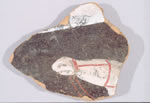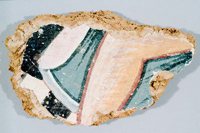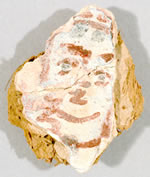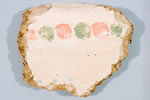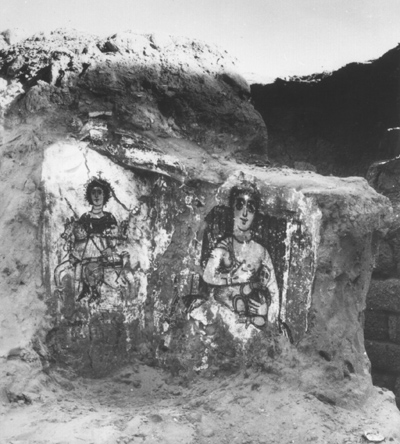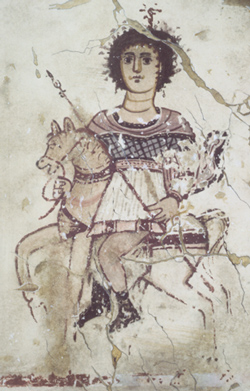
 |
 |
 |
 |
 |
 |
 |
 |
 |
The Images
In room E of house 124 archaeologists found three small pieces of wall paintings (in case 7). All three fragments did not come from the same wall: the mud plasters they are painted on are different, as are the colors of the backgrounds, as well as the scales of the figures and other motifs. One piece (no. 39) preserves just a line of red and green dots. Another (no. 38) preserves an image of the face of the infant Harpocrates holding a finger to the corner of his mouth. The third one (no. 37) shows a piece of cloth behind a bent arm or leg: the cloth is pink trimmed in white on one side and blueish-gray outlined in black on the other. A fourth painting fragment (no. 36) was found in the layer below, in a disturbed area with remains from various periods. Part of the head of a horse, wearing a red bridle, is preserved on this piece.
|
Although not all painted on the same wall, these fragments may well have belonged to the same decorative scheme in use through several architectural phases and periods of habitation. A similarly complex decorative scheme is illustrated by the photograph of the wall paintings at house B50 (see photo at right), which covered two adjacent walls with images of the goddess, Isis, holding her infant son, Harpocrates, on her lap and the soldier god, Heron, riding a horse. Several passages in the paintings from house B50 are strikingly similar to those on the fragments from house 124: Harpocrates with his finger to his mouth, the bridled head of the horse, and the bent knee against the blanket-covered back of the horse. There is a conspicuous contrast between the plainness of the textile artifacts and the special fabrics represented in the paintings (Harpocrates’ knitted socks and the fancy horse blanket). The paintings represent not the drab objects in use in this house in everyday life but the special fabrics of extra-ordinary circumstances. They convey the inhabitants’ expectations for what cloth could be. |
House B50, room E |
|
House B50, room E |
Heron, Isis, and HarpocratesDuring the Ptolemaic and Roman periods, the venerable Egyptian divinities Isis and her son, Harpocrates, acquired new attributes: Isis, for example, came to wear the distinctive costume of a shawl draped and knotted over her shoulders, leaving her breasts bare. At the same time, new divinities enter the Egyptian pantheon: Heron was closely associated with the militarized Horus, a mature aspect of Harpocrates. It is not at all unusual to find Heron dressed as a soldier. Early Holy IconsIn this usage of the term, icons are sacred images, representations of holy persons and events. These appear to have developed as images for private religious devotion in the home during the later Roman period, in the third and fourth centuries. The best evidence for early icons are paintings from Egypt, like the ones shown here. |
